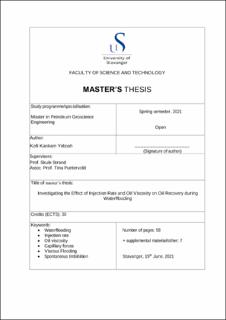| dc.description.abstract | For over a century, waterflooding of oil reservoirs have been performed to improve oil recovery for two reasons: to provide pressure support to the reservoir and to displace the oil entrapped in the pores of the rock. Researchers discovered that the wetting properties of the reservoir played a critical role in the efficiency of the waterflood. The backdrop for which numerous researches have been conducted is the significant improvement of the general understanding of the wetting properties of oil reservoirs, with the objective to optimize oil recovery. Apart from the gravity, viscous and capillary forces that are responsible for oil recovery in waterflooding experiments, several other factors influence oil recovery. Factors such as temperature, porosity and permeability of the rock system, formation water, mineralogy of the rock, acidic and basic components in oil among other factors influence oil recovery.
In this study, the effects of injection rate and oil viscosity in waterflooding of sandstones were examined. The main focus was to investigate the influence of capillary forces in mobilization of oil during waterflooding experiments. Two set of outcrop cores, Bandera brown and Leopard, were used for this study. Oils used in this study were synthetic oils which were prepared in the laboratory by mixing Marcol oil and n-heptane at different volume ratios. Two synthetic oils, one with a viscosity of 3cP (MO3) and the other with a viscosity of 11cP (MO11), were used for this study. Spontaneous imbibition experiments were carried out on the cores, with formation water being the imbibing brine. Subsequently, viscous flooding experiments were conducted on the cores at a high (4PV/day) and low injection rate (1PV/day).
Oil recovery during the spontaneous imbibition experiments of the cores yielded a significant amount of OOIP, which was an indication of the cores’ strong water wetness. Spontaneous imbibition is a capillary driven phenomena hence the driving force that is responsible for oil recovery are capillary forces, thus capillary forces contributes immensely in oil recovery.
It was drawn from this research that injection rate seem not to significantly affect oil recovery during waterflooding as observed with all the cores used in this study. Viscous flooding performed on the cores at high and low injection rate showed that oil viscosity and injection rate do not significantly affect oil recovery, confirming that capillary forces is important in the recovery process in water wet cores. | |
